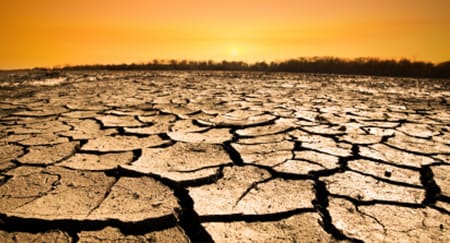Bjørn Lomborg argues that global warming’s effects on food scarcity can be addressed – and now. Furthermore, he paints a picture in which less people starve in the world, despite population growth. Here he sets out the action needed now.
We are often told that global warming is soon going to make it impossible to feed the planet. This dramatic overstatement of the truth leads us to focus on the wrong solutions.
When the Copenhagen Consensus Center convened a panel of Nobel Laureates to identify the best investments that could be made to help the planet, they highlighted incredibly cheap, highly effective ways to fight malnutrition, such as micronutrient supplementation, micronutrient fortification, biofortification, and community nutrition programmes.
Sadly, in the developed world we do not hear enough about these solutions – or even about this challenge. When we do focus on hunger, we often see it through the wrong lens.
The proportion of people starving has steadily declined since 1950 from more than 50% of the world’s population to less than 18% today
We have long worried about massive levels of future starvation: in 1968, Paul Ehrlich declared that humanity had already lost the battle to feed itself. His prediction of impending widespread starvation was based on the rudimentary idea that greater numbers of people inevitably mean less food for each individual.
In actual fact, the world’s population has doubled since 1961, but food production has almost tripled. The developing world’s population has slightly more than doubled while food production there has quadrupled.
The result has been rapidly rising calories available, especially in the developing world. The proportion of people starving has steadily declined since 1950 from more than 50% of the world’s population to less than 18% today. The longest-term UN scenarios expect this proportion to drop steadily toward 2.9% in 2050. This will still represent 290 million people undernourished at that time.
Several large-scale surveys that have looked at the effect of climate change on agricultural production and the global food trade system have four crucial findings in common.
First, they envision a large increase in agricultural output – more than a doubling of cereal production over the coming century. In the words of one modeling team: “Globally, land and crop resources, together with technological progress, appear to be sufficient to feed a world population of about 9 billion people in 2080.”
The most pessimistic models, expecting the most pessimistic climate impacts, expect a total reduction of agricultural production of 1.4% compared to a scenario without any climate change
Second, the impact of global warming on agricultural production will probably be negative, but in total very modest. The most pessimistic models, expecting the most pessimistic climate impacts, expect a total reduction of agricultural production of 1.4% compared to a scenario without any climate change. The most optimistic model forecasts a net increase in agricultural production from global warming of 1.7%. To put these numbers in perspective, the average growth rate for agriculture over the past 30 years was about 1.7%.
Third, while there will be little change globally, this is not true regionally. In general terms, global warming has a negative impact on developing nations’ agriculture but a positive impact on developed nations’ agriculture. This cruel reality is because temperature increases are helpful for farmers in high latitudes (bringing longer growth seasons, multiple crops, and higher yields) but mean lower productivity for those in tropical countries.
In worst-case scenarios, this will mean a 7% decrease in yield in the developing world and a 3% increase in the developed world. This is an issue that we must address, but we should also note the bigger picture: total production even in the least developed countries is expected to rise by about 270%.
Over the coming century, developing nations will inevitably become more dependent on food imports from developed countries. This is not primarily a global warming phenomenon: even without global warming, imports for least developed countries would double over the century because of demographics. Global warming causes the import increase to go from about 100% to %110-140%.
We should keep in mind that developing country consumers in 2080 will be considerably better off than they are today. One modeling team points out that future developing nation consumers “are largely separated from agricultural production processes, dwelling in cities and earning incomes in the non-agricultural sectors. As in today’s developed countries, consumption levels depend largely on food prices and incomes rather than on changes in domestic agricultural production.”
Fourth, overall, global warming will be responsible for up to 28 million more malnourished people in the most likely scenario. (Other scenarios show lower impacts, ranging down to global warming causing an overall reduction in the number of malnourished people by 28 million).
The extent of hunger depends less on climate and more on economics
It is important to put this into context. The world now has about 925 million malnourished. Over the coming century we will add at least 2-3 billion more people, yet it is likely that towards the end of the century, there will be ‘only’ about 108 million people starving.
The extent of hunger depends less on climate and more on economics. Even dramatically controlling global warming (imagine that we somehow halted emissions today) would maximally avoid 28 million people from going hungry by the end of the century. By comparison, if we manage to move from one of the UN’s less economically effective scenarios to one of the more effective scenarios, we could avoid 1,065 million hungry people by the end of the century.
Of course, it is utterly unrealistic to think that we could entirely stop either global warming or the economic aspects of hunger. But what we should attempt to do is to find the scenario gives us the lowest absolute number of hungry people – and this is correlated with making incomes the highest.
Using climate policy to obtain a small reduction is simply not a sound or ethical strategy. Carbon cuts create a small, far-off change in temperature rises. If the Kyoto Protocol had been fully implemented, this would have reduced malnutrition by just 2 million people in 2080, at an annual cost of $180 billion.
However, if we really care about helping the hungry, we can do much better.
This is where cheap, effective responses to malnutrition enter the picture. The Nobel Laureate Expert Panel that recommended greater investment in micronutrient supplementation, micronutrient fortification, biofortification, and community nutrition programmes in the Copenhagen Consensus 2008 project did so because even tiny investments in these areas can make a powerful difference.
Through fortifying basic food items (such as with iron), developing more nutritious crops, and ensuring more comprehensive delivery of micronutrient supplements, we can deal much better with the often overlooked problem of undernutrition. Community nutrition programmes can help to deliver sustainable improvements that benefit families and the entire community in the long run. (For the research underpinning these recommendations, see: www.copenhagenconsensus.com)
We must recognize that the extent of hunger depends very little on climate
Other highly ranked investments by the Nobel Laureate Expert Panel, such as the expansion of vaccination and deworming coverage, improved malaria prevention and treatment, and lowering barriers to girls’ schooling, would deliver lasting changes that would make the world’s most vulnerable communities stronger and more resilient.
If we care about helping the most people escape from hunger then we must recognize that the extent of hunger depends very little on climate and much more on economics.




